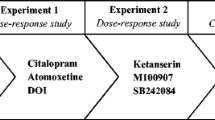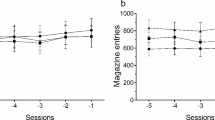Abstract
The effects of clozapine (CLOZ) upon acquired schedule-induced polydipsia in rats were compared to the effects of the dopamine (DA) D1 antagonist SCH 23390 (SCH) and the DA D2 antagonist raclopride (RAC). All three compounds suppressed water consumption, but only SCH and RAC decreased drinking efficiency. SCH was the only compound with an effect on panel pressing (PP), causing suppression even at a dose without effect upon water intake. SCH also affected the temporal pattern of licking (TPL) at all doses, while clozapine, 10 mg/kg, only affected the pattern acutely, and raclopride was without effect. In conclusion, PP and the TPL are more sensitive to D1 than D2 blockade. While PP and the TPL are more sensitive than water intake to D1 blockade, the opposite is true for D2 blockade. It is possible to differentiate between DA D1/D2 antagonists and CLOZ in this model, focusing upon reduction in water consumption, with and without reduction in drinking efficiency. Furthermore, it is possible to differentiate between D1 and D2 blockade by analyzing water consumption, PP and the TPL.
Similar content being viewed by others
References
Baldessarini RJ, Huston-Lyons D, Campbell A, Marsh E, Cohen BM (1992) Do central antiadrenergic actions contribute to the atypical properties of clozapine? Br J Psychiatry 160[suppl. 17]:12–16
Carlsson A (1978) Antipsychotic drugs, neurotransmitters, and schizophrenia. Am J Psychiatry 135[2]:164–173
Chiodo LA, Bunney BS (1983) Typical and atypical neuroleptics: differential effects of chronic administration on the activity of A9 and A10 midbrain dopaminergic neurons. J Neurosci 3[8]:1607–1619
Christensen AV (1990) Long-term effects of dopamine D-1 and D-2 antagonists in Vervet monkeys. Behav Neurol 3:49–60
Christensen AV, Arnt J, Svendsen O (1985) Pharmacological differentiation of dopamine D-1 and D-2 antagonists after single and repeated administration. In: Casey DE, Chase TN, Christensen AV, Gerlach J (eds) Dyskinesia, research and treatment, Psychopharmacology supplementum 2. Springer, Berlin Heidelberg, pp 182–190
Coffin VL, Latranyi MB, Chipkin RE (1989) Acute extrapyramidal syndrome in cebus monkeys: development mediated by dopamine D2 but not D1 receptors. J Pharmacol Exp Ther 249[3]:769–774
Delini-Stula A (1986) Neuroanatomical, neuropharmacological and neurobiochemical target systems for antipsychotic activity of neuroleptics. Pharmacopsychiatry 19:134–139
Falk JL (1961) Production of polydipsia in normal rats by an intermittent food schedule. Science 133:195–196
Falk JL (1971) Theoretical review. The nature and determinants of adjunctive behaviour. Physiol Behav 6:577–588
Farde L, Wiesel FA, Nordström A-L, Sedvall G (1989) D1- and D2-dopamine receptor occupancy during treatment with conventional and atypical neuroleptics. Psychopharmacology 99:28–31
Fitton A, Heel RC (1990) Clozapine, a review of its pharmacological properties, and therapeutic use in schizophrenia. Drugs 40[5]:722–747
Gerlach J (1991) Current views on tardive dyskinesia. Pharmacopsychiatry 24:47–48
Hietala J, Lappalainen J, Koulu M, Syvälathi E (1990) Dopamine D1 receptor antagonism in schizophrenia: is there reduced risk of extrapyramidal side-effects? TIPS 11:406–410
Hyttel J (1983) SCH 23390 — the first selective dopamine D-1 antagonist. Eur J Pharmacol 91:153–154
Hyttel J, Arnt J (1987) Characterization of binding of3H-SCH 23390 to dopamine D-1 receptors. Correlation to other D-1 and D-2 measures and effect of selective lesions. J Neural Transm 68:171–189
Imperato A, Mulas A, Di Chiara G (1987) The D-1 antagonist SCH 23390 stimulates while the D-1 agonist SKF 38393 fails to affect dopamine release in the dorsal caudate of freely moving rats. Eur J Pharmacol 142:177–181
Lindström LH (1988) The effect of long-term treatment with clozapine in schizophrenia: a retrospective study in 96 patients treated with clozapine for up to 13 years. Acta Psychiatr Scand 77:524–529
Ljungberg T (1989a) Attenuation of water intake and operant responding by dopamine D2 antagonists: raclopride provides important cues for understanding the functional mechanism of action. Pharmacol Toxicol 65:9–12
Ljungberg T (1989b) Effects of the dopamine D-1 antagonist SCH 23390 on water intake, water-rewarded operant responding and apomorphine-induced decrease of water intake in rats. Pharmacol Biochem Behav 33:709–712
Meltzer HY (1991) Dopaminergic and serotonergic mechanisms in the action of clozapine. In: Tamminga CA, Schulz SC (eds) Advances in neuropsychiatry and psychopharmacology, Vol. 1: Schizophrenia research. Raven, New York
Meltzer HY, Alphs LD, Bastani B, Ramirez LF, Kwon K (1991) Clinical efficacy of clozapine in the treatment of schizophrenia. Pharmacopsychiatry 24:44–45
Mittleman G, Valenstein ES (1985) Individual differences in non-regulatory ingestive behaviour and catecholamine systems. Brain Res 348:112–117
Mittleman G, Jones GH, Robbins TW (1988) The relationship between schedule-induced polydipsia and pituitary-adrenal activity: pharmacological and behavioural manipulations. Behav Brain Res 28:315–324
Mittleman G, Jones GH, Whishaw IQ, Koch M, Robbins TW (1990) Cortical, hippocampal, and striatal mediation of schedule-induced behaviours. Behav Neurosci 104[3]:399–409
Ögren SO, Hall H, Köhler C, Magnusson O, Sjöstrand SE (1986) The selective dopamine D2 receptor antagonist raclopride discriminates between dopamine-mediated motor functions. Psychopharmacology 90:287–294
Porter JH, McDonough JJ, Heather GF, Goldsmith PA, Johnson DN (1984) Differential effects of dopamine blockers on the acquisition of schedule-induced drinking and deprivation-induced drinking. Physiol Psychol 12:302–306
Robbins TW, Koob GF (1980) Selective disruption of displacement behaviour by lesions of the mesolimbic dopamine system. Nature 285[5764]:409–412
Robbins TW, Roberts DCS, Koob GF (1983) Effects ofd-amphetamine and apomorphine upon operant behaviour and schedule-induced licking in rats with 6-hydroxydopamine-induced lesions of the nucleus accumbens. J Pharmacol Exp Ther 224[3]:662–673
Seeman P (1990) Atypical neuroleptics: role of multiple receptors, endogenous dopamine, and receptor linkage. Acta Psychiatr Scand 82[suppl.358]:14–20
Skarsfeldt T (1988) Differential effects after repeated treatment with haloperidol, clozapine, thioridazine and tefludazine on SNC and VTA dopamine neurons in rats. Life Sci 42:1037–1044
Todd KG, Beck CHM, Martin-Iverson MT (1992) Effects of D1 and D2 dopamine antagonists on behavior of polydipsic rats. Pharmacol Biochem Behav 42:381–388
Van Tol HHM, Bunzow JR, Guan H-C, Sunahara RK, Seeman P, Niznik BH, Civelli O (1991) Cloning of the gene for a human dopamine D4 receptor with high affinity for the antipsychotic clozapine. Nature 350:610–614
Wallace M, Singer G, Finlay J. Gibson S (1983) The effect of 6-OHDA lesions of the nucleus accumbens septum on schedule-induced drinking, wheelrunning and corticosterone levels in the rat. Pharmacol Biochem Behav 18:129–136
White FJ, Wang RY (1983) Differential effects of classical and atypical antipsychotic drugs on A9 and A10 dopamine neurons. Science 221:1054–1057
Author information
Authors and Affiliations
Rights and permissions
About this article
Cite this article
Didriksen, M., Olsen, G.M. & Christensen, A.V. Effect of clozapine upon schedule-induced polydipsia (SIP) resembles neither the actions of dopamine D1 nor D2 blockade. Psychopharmacology 113, 250–256 (1993). https://doi.org/10.1007/BF02245706
Received:
Revised:
Issue Date:
DOI: https://doi.org/10.1007/BF02245706




